Introduction
Today’s article is written by my Facebook friend Stephen Ordway. Stephen is a fellow Vietnam War Veteran and a former Green Beret. Many of us are familiar with the Green Berets, a storied U.S. Army Special Forces group, defined by the unique head cover and emblem which sets them apart.
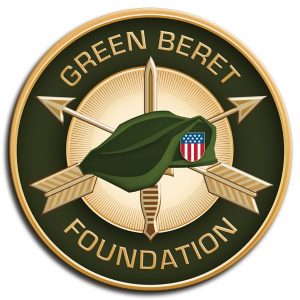 Today’s U.S. military Special Forces groups were spawned in the Asian theater during World War II, and were then very active in the Korean War as well. John F. Kennedy’s involvement with the Special Forces units, during the early years of the Vietnam War, expanded the duty and scope of special forces and initiated the unit known as the Green Berets. Green Beret training is among the most intense and grueling training of any military unit worldwide.
Today’s U.S. military Special Forces groups were spawned in the Asian theater during World War II, and were then very active in the Korean War as well. John F. Kennedy’s involvement with the Special Forces units, during the early years of the Vietnam War, expanded the duty and scope of special forces and initiated the unit known as the Green Berets. Green Beret training is among the most intense and grueling training of any military unit worldwide.
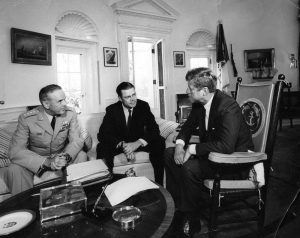 Highly noted for their actions during the Vietnam War, the Green Berets conducted covert, and overt activities under some of the most difficult conditions of the war. They have since been active in all other U.S. conflicts as well.
Highly noted for their actions during the Vietnam War, the Green Berets conducted covert, and overt activities under some of the most difficult conditions of the war. They have since been active in all other U.S. conflicts as well.
My exposure to the Green Berets during my time in Vietnam was limited to seeing them come through our base at Phu Cat from time to time. Always in small units, they typically stopped for re-supply and then disappeared into the foreboding mountain range to our west, which was frequently the source of mortar and rocket attacks on our base. I rarely witnessed their return from those mountains.
I am honored that Stephen has shared this story with us, please enjoy it.
Reflections From an Old Sheepdog #44
Stephen Ordway
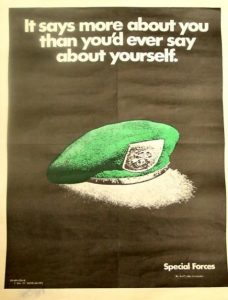 I have tried to write this so many times before. Between shutting down memories with tears and getting lost in them, I’ve hit time and again one of my own very well-built mental walls. This tale begins when I went to Vietnam in August of 1969. Stepping off a plane into a heat that was so hot that the air was, at first, hard to breath, cutting into our lungs with each gasp. We got sent to an island just off the coast to get what is known as climatized. There, we spent two days hiking up and down a hill with a sandbag in a backpack. For me – it was even hotter. I was running a high fever from what I found out was tonsillitis. From the island, they sent me to a hospital – where they sat me in a dental chair and proceeded to remove my tonsils, after doping me up. After recovering for 24 hours, from there – I was sent to Ban Me Thout, known as a B-team site, B-23. I worked in the radio room monitoring the A-teams and men in the field. I stayed there about three months. After that, I was sent out in the beginning of Dec to an A team that had just lost two very good men to the enemy.
I have tried to write this so many times before. Between shutting down memories with tears and getting lost in them, I’ve hit time and again one of my own very well-built mental walls. This tale begins when I went to Vietnam in August of 1969. Stepping off a plane into a heat that was so hot that the air was, at first, hard to breath, cutting into our lungs with each gasp. We got sent to an island just off the coast to get what is known as climatized. There, we spent two days hiking up and down a hill with a sandbag in a backpack. For me – it was even hotter. I was running a high fever from what I found out was tonsillitis. From the island, they sent me to a hospital – where they sat me in a dental chair and proceeded to remove my tonsils, after doping me up. After recovering for 24 hours, from there – I was sent to Ban Me Thout, known as a B-team site, B-23. I worked in the radio room monitoring the A-teams and men in the field. I stayed there about three months. After that, I was sent out in the beginning of Dec to an A team that had just lost two very good men to the enemy.
I’ve tried so hard to remember the real experience without changing the facts or embellishing the story. Our memories play us worse that any scam artist ever could. I had been trained by the very best the military had to offer, to work with the very best, this was true. The weeding out process was in every way what it should have been – very hard both mentally and physically, defeating some of the very toughest men – and yet, somehow, I had passed everything. My stutter had gotten better. I rarely talked to anyone and hid the fact that I had both dyslexia and ADHD. Finally, here I was in Vietnam, a member of the Special Forces wearing a Green Beret. This part is maybe the hardest to explain. Men came from all walks of life and from most every state to join this group. The Beret does not make the man. But it does define him. The honor to wear one, what it takes from inside each of us, I believe pushes us beyond any limits we may have ever unconsciously had. You are a member of a family, a very unique group of men, men that you don’t know, have never met, who would die for you and you for them. That is in no way an exaggeration. None of them were ever meant to feel like they were superman, yet time after time, while I lived in that country, I saw men, knew of men, simple everyday men, who became almost invincible – charging time and again into the firefight without hesitation. This was what they had been truly trained to do – with no thought of harm to themselves or ever any kind of accolades – but instead to save others, to cut down the enemy even when the odds were so against them. These men led from the front, rallying time and time again the young Montagnard boys to fight side by side with them – laughing in the face of an overwhelming enemy that just kept coming – and in doing so drove them back and broke their spirit. Men that didn’t consider dying as an option.
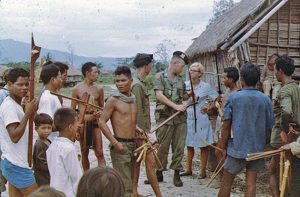
Green Beret assisting Montagnard villagers
My first A-camp was Duc Lap. An ugly hill on the Cambodian border of red clay that got into and under your skin to the point that whenever you tried to shower, the waters ran red for as long as the water would run. Nearest to us was Bu Prang another Special Forces camp hammered to the point of total destruction. The battles for these two camps are easy to lookup. I would never try to tell their stories. I wouldn’t tell them right anyway. Instead, I will tell you about what I remember of the people and some of the Americans that lived there. American Special Forces A-teams were normally 12-man teams that worked with tribal people known as Montagnards. These people were like no others I have ever met anywhere. We called them our “little people,” they were short, light-brown skinned, round-eyed and totally hated by the Vietnamese of both the north and the south. They lived primarily in the central highlands of Vietnam bordering Cambodia. In the jungle mountains. they wore loin cloths and hunted for food with a crossbow. They could take their families and disappear into the mountain mists when threatened by harm. American Special Forces were sent into these mountains during the early sixties to stop the flow of enemy troops into South Vietnam from North Vietnam through Cambodia into the Central Highlands. I will not lie – we loved our “little people.” We were their shepherds and would do anything for them as if they were our own children. Boys were treated by all as men, and were soldiers fighting an enemy that hated them. They trusted us, would die for us and in turn, our teams would die for them.
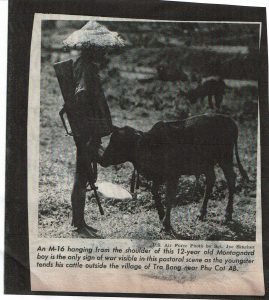
The mountains near our base were home to the “Yards”.
My memories of those times often blur, sometimes due to the pain and losses of life; sometimes due to tears, and also now, in all honesty, due to my age and a memory beginning to leave me. For those men that I served with, forgive me my mistakes in writing about those times.
When I arrived at Duc Lap, the team Sgt’s name was Jack Bagby, radio name (Blackjack). Each person had a nickname for radio purposes. We had a CO, commanding officer Cpt. Quick. Other names that stand out now are Lt. Jim Blanchard, (Rabbit), Lt. Saathoff (Blue Max), Lt. Schnably KIA, Sgt. Hudson (Brillo), Sgt. Jim Godwin, Sgt. Alan ‘Buddy” Brueck, (Lizard), Medics – Sgt Stephen Ragsdale–KIA, Sfc. Jack Joplin, and Sgt. Tom Hinton. Because of injuries, deaths, people going and coming due to either going out on operations in the field or returning to the states, or the loaning out of men to other teams that needed them, there was a constant ebb and flow of SF Americans. Two team members were killed, (KIA) during a mortar attack on the camp on Dec.1, 1969. Their loss was overwhelming to all.
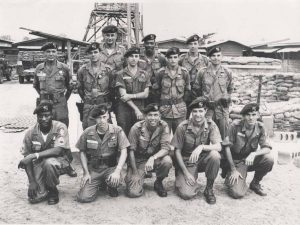
A Green Beret unit in Vietnam. They were not often in base camp.
There were three people that stood out the most from my time at Duc Lap that I respected and would like to write about. All three stood out for different reason, all were “crazy” each in their own way. I guess maybe anyone that joined and stayed in Special Forces had to be a little “crazy” maybe even a lot “crazy.” Rabbit, Lt. Blanchard, one of the finest leaders in my life that I have ever known, was always grinning down at the enemy, standing on the point of the camp, no shirt, shouting down at the enemy with his M-16 ready to fire – daring them to try and take him out, never backing off no matter what we were getting hit with – screaming at them “is that the best you’ve got?!” As I said, a step off. Tom Hinton, one of our medics, covered in blood, trying to save anyone and everyone, tears running down his cheeks when no matter what he did, he couldn’t. The best field doctor I would ever work with. He would carry the war and the losses with him all his life, never recovering from the people he couldn’t save until he gave in to his pain and Tom passed on, I was told. Finally, I come to Lizard, Sgt. Brueck – who taught me to just keep going. Nothing could stop him. Buddy, like me, ended up with two different forms of malaria. He lost at least 30 lbs. to Dengue fever. He got so thin, he could have blown away in the slightest breeze. He rarely spoke to me. He wasn’t much of a talker. Instead leading by example, sometime going days without more then maybe an hour sleep when teams in the field were in contact with the enemy, ready to assist in any way. He would become so intense during contact, you’d swear he could feel each round coming in and going out, passing through his own body, glaring at anyone or anything that might get in the way of him helping anyone that needed it. Nothing, not even his own body wracked with disease, would have or could have stopped him from doing his job. This is what those men that survived the training in Fort Bragg were made to be – men that could never, would never give up or give in.
Each man in his own way acted above and beyond what would be expected of a normal man. Each man not only pulled his on weight twice over, but helped carry the weight of those hit or those that had fallen. Those men of Special Forces never spoke of medals or what they did, never claimed to be supermen or invincible – but as a team they were, and in the eyes of the enemy they were. They could be shot and they could even at times be killed, but they could not as a team, as a group of men, ever be defeated or broken.
These small teams of men, scattered throughout those mountains so very long ago – many never to have ever met; nor would they ever meet other than by voices over the radios – became family – bonded together by blood, both their own and those of the “little people.” You see, for those that wore them then and those that today wear the Green Beret – the Beret did not make the man. But it has always been what the Beret stands for both then and now. The team, the small special band of brothers that stands just a little bit taller, a little bit straighter, than all others – not because they are invincible; not because they are supermen, each one of them – but because together, they will never yield; never give in – no matter the odds. You see, they just can’t.
~Stephen Ordway
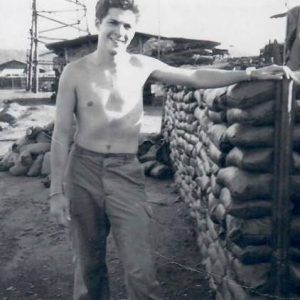 Stephen D. Ordway enlisted in the United States Army in January of 1968. He completed Airborne school, and with additional training became a member of the Fifth Special Forces Group. As a Green Beret, he served in Vietnam during 1969 and 1970. Upon returning to the United States, Stephen achieved degrees in Public Administration and Psychology, and Masters credits in Special Education and in Clinical Psychology. He has been a member of Crimestoppers; a parenting time supervisor; and a special investigator for a child advocacy practice in New Jersey. Stephen and his wife have a total of nine children, two of whom still live with them in Gilbert, Arizona. Stephen is currently retired.
Stephen D. Ordway enlisted in the United States Army in January of 1968. He completed Airborne school, and with additional training became a member of the Fifth Special Forces Group. As a Green Beret, he served in Vietnam during 1969 and 1970. Upon returning to the United States, Stephen achieved degrees in Public Administration and Psychology, and Masters credits in Special Education and in Clinical Psychology. He has been a member of Crimestoppers; a parenting time supervisor; and a special investigator for a child advocacy practice in New Jersey. Stephen and his wife have a total of nine children, two of whom still live with them in Gilbert, Arizona. Stephen is currently retired.
Note: Feel free to leave any comments for Stephen.
Click on any photo to enlarge.
Updated: January 2, 2020 at 7:14 am
About the Author
Joe Campolo Jr.
Joe Campolo, Jr. is an award winning author, poet and public speaker. A Vietnam War Veteran, Joe writes and speaks about the war and many other topics. See the "Author Page" of this website for more information on Joe.
Guest writers on Joe's blogs will have a short bio with each article. Select blogs by category and enjoy the many other articles available here.
Joe's popular books are available thru Amazon, this website, and many other on-line book stores.
 Today’s U.S. military Special Forces groups were spawned in the Asian theater during World War II, and were then very active in the Korean War as well. John F. Kennedy’s involvement with the Special Forces units, during the early years of the Vietnam War, expanded the duty and scope of special forces and initiated the unit known as the Green Berets. Green Beret training is among the most intense and grueling training of any military unit worldwide.
Today’s U.S. military Special Forces groups were spawned in the Asian theater during World War II, and were then very active in the Korean War as well. John F. Kennedy’s involvement with the Special Forces units, during the early years of the Vietnam War, expanded the duty and scope of special forces and initiated the unit known as the Green Berets. Green Beret training is among the most intense and grueling training of any military unit worldwide. Highly noted for their actions during the Vietnam War, the Green Berets conducted covert, and overt activities under some of the most difficult conditions of the war. They have since been active in all other U.S. conflicts as well.
Highly noted for their actions during the Vietnam War, the Green Berets conducted covert, and overt activities under some of the most difficult conditions of the war. They have since been active in all other U.S. conflicts as well. I have tried to write this so many times before. Between shutting down memories with tears and getting lost in them, I’ve hit time and again one of my own very well-built mental walls. This tale begins when I went to Vietnam in August of 1969. Stepping off a plane into a heat that was so hot that the air was, at first, hard to breath, cutting into our lungs with each gasp. We got sent to an island just off the coast to get what is known as climatized. There, we spent two days hiking up and down a hill with a sandbag in a backpack. For me – it was even hotter. I was running a high fever from what I found out was tonsillitis. From the island, they sent me to a hospital – where they sat me in a dental chair and proceeded to remove my tonsils, after doping me up. After recovering for 24 hours, from there – I was sent to Ban Me Thout, known as a B-team site, B-23. I worked in the radio room monitoring the A-teams and men in the field. I stayed there about three months. After that, I was sent out in the beginning of Dec to an A team that had just lost two very good men to the enemy.
I have tried to write this so many times before. Between shutting down memories with tears and getting lost in them, I’ve hit time and again one of my own very well-built mental walls. This tale begins when I went to Vietnam in August of 1969. Stepping off a plane into a heat that was so hot that the air was, at first, hard to breath, cutting into our lungs with each gasp. We got sent to an island just off the coast to get what is known as climatized. There, we spent two days hiking up and down a hill with a sandbag in a backpack. For me – it was even hotter. I was running a high fever from what I found out was tonsillitis. From the island, they sent me to a hospital – where they sat me in a dental chair and proceeded to remove my tonsils, after doping me up. After recovering for 24 hours, from there – I was sent to Ban Me Thout, known as a B-team site, B-23. I worked in the radio room monitoring the A-teams and men in the field. I stayed there about three months. After that, I was sent out in the beginning of Dec to an A team that had just lost two very good men to the enemy. Stephen D. Ordway enlisted in the United States Army in January of 1968. He completed Airborne school, and with additional training became a member of the Fifth Special Forces Group. As a Green Beret, he served in Vietnam during 1969 and 1970. Upon returning to the United States, Stephen achieved degrees in Public Administration and Psychology, and Masters credits in Special Education and in Clinical Psychology. He has been a member of Crimestoppers; a parenting time supervisor; and a special investigator for a child advocacy practice in New Jersey. Stephen and his wife have a total of nine children, two of whom still live with them in Gilbert, Arizona. Stephen is currently retired.
Stephen D. Ordway enlisted in the United States Army in January of 1968. He completed Airborne school, and with additional training became a member of the Fifth Special Forces Group. As a Green Beret, he served in Vietnam during 1969 and 1970. Upon returning to the United States, Stephen achieved degrees in Public Administration and Psychology, and Masters credits in Special Education and in Clinical Psychology. He has been a member of Crimestoppers; a parenting time supervisor; and a special investigator for a child advocacy practice in New Jersey. Stephen and his wife have a total of nine children, two of whom still live with them in Gilbert, Arizona. Stephen is currently retired.


I truly enjoyed reading Stephen’s story – a most appropriate one for Memorial Day Week; sharing those memories of lost brothers. Thank you, Stephen, for your service, and you, Joe, for publishing this fine article. Bless you, both!
Thanks John!
Thank you for sharing this story. I wish I could find out more information because my dad was a Green Beret named Jack Bagby, sadly I did not get to know him as my parents divorced.
I will share your message with Stephen, Tammy.
Please contact me directly and I will help fill in some blanks about your Dad
We owe so much to the men and women that served in America’s forgotten war. Unforgotten by those that were there, those that served at the highest levels of Duty, Honor, and Country.
There is no such thing as an un-wounded soldier.
God Bless you All.
Thank you for the feedback and kind words Max.
DearJoe, Recently I open a cardboard box covered it grim and dust from about 50 years ago that I had never opened just instead moving it from home to home throughout my life. In it were things from my childhood that my Mom had packed up and saved. IIn it also were the letters I had written home from Virtnam and the B-team and two border camps I served in. I actually found letters from Duc Lap placing me there in November of 69. I had been sent to the field, I think my third time out, when Dutch and Steve were killed on the 1st of December in a mortar attack killing both at the same moment just outside our teamhouse trying to return fire from the nearest mortar pit in camp.
Wow, sorry to hear of the loss of your friends like that.
Steve Ragsdale was my cousin…